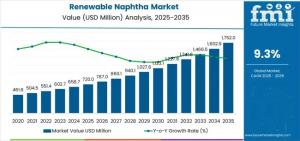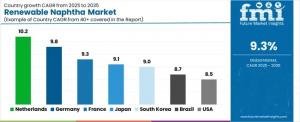Renewable Naphtha Market Set to Surge Across APAC, Europe, USA, and Saudi Arabia with 9.3% CAGR Growth by 2035,
Light Naphtha will dominate with a 63.1% market share, while fuel blending will lead the application segment with a 58.2% share.
ICHIHARA, SODEGAURA, CHIBA, JAPAN, November 11, 2025 /EINPresswire.com/ -- The global renewable naphtha market is entering a phase of transformative growth, expanding from a valuation of USD 720 million in 2025 to a projected USD 1,752 million by 2035, representing an absolute increase of USD 1,050 million and a CAGR of 9.3%, according to Future Market Insights (FMI). This robust expansion underscores the accelerating adoption of low-carbon feedstocks in petrochemical applications and the rising demand for sustainable solutions in fuel blending and plastics production across the globe.
Market Dynamics and Key Drivers
The market’s momentum is being fueled by regulatory frameworks prioritizing carbon reduction, corporate sustainability mandates, and the global shift toward circular economy principles. Between 2025 and 2030, renewable naphtha is expected to grow by 38.4%, reaching USD 1,123.5 million, primarily driven by the adoption of ISCC+ and mass-balance certification systems, which facilitate traceable, bio-attributed polymers.
From 2030 to 2035, a more accelerated growth phase is projected, contributing 61.6% of total market expansion, driven by integrated biorefinery platforms, waste-oil aggregation networks, and advanced co-processing technologies. These innovations are critical in meeting the rising demand for renewable naphtha in sustainable aviation fuel intermediates and bio-attributed polymer production.
Request the complete report to gain a clear understanding of regional growth patterns, innovation trends, and competitive intelligence! Request Sample Report: https://www.futuremarketinsights.com/reports/sample/rep-gb-7740
Regional Insights: Europe, APAC, USA, and Saudi Arabia
- Europe is leading market adoption, with Germany, the Netherlands, and France emerging as primary hubs. Germany’s extensive cracker infrastructure, early adoption of mass-balance certified polymers, and circular economy initiatives position it at 9.8% CAGR. The Netherlands, benefiting from Rotterdam-Moerdijk’s strategic port and refinery network, is set to achieve 10.2% CAGR, while France leverages integrated biorefinery platforms to support renewable naphtha and sustainable aviation fuel production (9.3% CAGR).
- Asia Pacific markets such as Japan and South Korea are accelerating adoption aligned with net-zero roadmaps. Japan’s focus on bio-attributed resin feedstocks is driving 9.1% CAGR, while South Korea emphasizes refiner transformation and low-carbon feedstock integration (9% CAGR).
- United States growth is projected at 8.5% CAGR, supported by renewable fuel standard incentives, expanding bioplastics adoption, and strengthened waste-oil aggregation networks enabling co-processing at major refining centers.
- Saudi Arabia, as part of the Middle East, is seeing rising interest in renewable naphtha to support low-carbon fuel blending and petrochemical decarbonization initiatives, aligning with regional energy diversification and circular economy strategies.
Segmental Performance
- Product Type: Light naphtha dominates with a 63.1% market share in 2025, favored for steam cracker operations and bio-attributed polymer production due to its optimal boiling range and high olefin yields.
- Application: Fuel blending leads with 58.2% market share, owing to drop-in compatibility with gasoline, verified carbon intensity reductions, and regulatory compliance support.
- Feedstock: Used cooking oil and waste fats account for the largest share (42%) of production, offering both economic and sustainability advantages. Vegetable oils and residues contribute 28%, while advanced bio-oils and pyrolysis oils hold 12%.
- Certification/Traceability: ISCC+/ISCC EU dominates (82% share), ensuring global compliance, mass-balance methodology adoption, and verified carbon reductions.
- Processing Route: Co-processing in integrated refineries/biorefineries leads (61% share) due to capital efficiency and operational flexibility, while standalone renewable units account for 39%.
Gain complete access to the report for extensive coverage of market forecasts, competitive benchmarking, and evolving industry trends! Buy Full Report: https://www.futuremarketinsights.com/checkout/7740
Technological Trends and Market Innovation
Renewable naphtha producers are investing in integrated biorefinery platforms, advanced feedstock aggregation networks, and proprietary conversion technologies. These initiatives enhance product yields, lower carbon intensity, and expand feedstock flexibility, reinforcing renewable naphtha’s role as a drop-in low-carbon alternative.
The market is also witnessing the widening adoption of circular economy principles, particularly in packaging and sustainable materials, enabling traceable, mass-balance compliant polymer production. Brand owners increasingly demand renewable feedstocks that deliver verified sustainability credentials without compromising operational flexibility.
Outlook and Future Opportunities
FMI forecasts that renewable naphtha’s role in petrochemical and fuel sectors will continue to strengthen, with adoption driven by:
- Expansion of mass-balance certification frameworks and carbon accounting systems.
- Investment in waste-based feedstock sourcing, optimizing circular economy value streams.
- Development of integrated biorefineries and co-processing infrastructure.
- Strategic collaborations among petrochemical producers, brand owners, and investors to enable long-term sustainable supply.
The global renewable naphtha market is poised for significant transformation across Europe, APAC, USA, and Saudi Arabia, with light naphtha for fuel blending and polymer applications driving a shift toward decarbonized petrochemical operations. The market trajectory signals an era where low-carbon, certified feedstocks become central to corporate sustainability commitments and regulatory compliance objectives.
Exploring Insights Across Emerging Global Markets:
Tinted Glass Market: https://www.futuremarketinsights.com/reports/tinted-glass-market
Carbon Steel Market: https://www.futuremarketinsights.com/reports/carbon-steel-market
Cold Plates Market: https://www.futuremarketinsights.com/reports/cold-plates-market
Hydrazine Hydrate Market: https://www.futuremarketinsights.com/reports/hydrazine-hydrate-market
About Future Market Insights (FMI)
Future Market Insights, Inc. (FMI) is an ESOMAR-certified, ISO 9001:2015 market research and consulting organization, trusted by Fortune 500 clients and global enterprises. With operations in the U.S., UK, India, and Dubai, FMI provides data-backed insights and strategic intelligence across 30+ industries and 1200 markets worldwide.
Why Choose FMI: Empowering Decisions that Drive Real-World Outcomes: https://www.futuremarketinsights.com/why-fmi
Sudip Saha
Future Market Insights Inc.
+1 347-918-3531
email us here
Legal Disclaimer:
EIN Presswire provides this news content "as is" without warranty of any kind. We do not accept any responsibility or liability for the accuracy, content, images, videos, licenses, completeness, legality, or reliability of the information contained in this article. If you have any complaints or copyright issues related to this article, kindly contact the author above.


